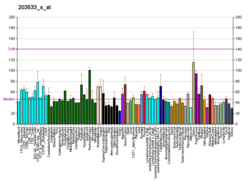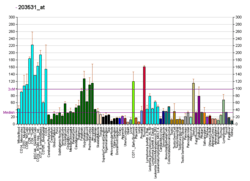CUL5
Cullin-5 is a protein that in humans is encoded by the CUL5 gene.[3][4][5]
Discovery
The mammalian gene product was originally discovered by expression cloning, due to the protein's ability to mobilize intracellular calcium in response to the peptide hormone arginine vasopressin. It was first titled VACM-1, for vasopressin-activated, calcium-mobilizing receptor.[6] Since then, VACM-1 has been shown to be homologous to the Cullin family of proteins, and was subsequently dubbed cul5.
Tissue distribution
Studies have shown that the cul5 protein is expressed at its highest levels in heart and skeletal tissue, and is specifically expressed in vascular endothelium and renal collecting tubules.[7]
Function
Cul5 inhibits cellular proliferation, potentially through its involvement in the SOCS/ BC-box/ eloBC/ cul5/ RING E3 ligase complex, which functions as part of the ubiquitin system for protein degradation.[8]
One study have shown that Cul5 plays a role in Reelin signaling cascade, participating in the DAB1 degradation and thus ensuring the negative feedback mechanism of Reelin signaling during corticogenesis.[9]
Interactions
CUL5 has been shown to interact with RBX1.[10][11]
References
- ↑ "Human PubMed Reference:".
- ↑ "Mouse PubMed Reference:".
- ↑ Kipreos ET, Lander LE, Wing JP, He WW, Hedgecock EM (Aug 1996). "cul-1 is required for cell cycle exit in C. elegans and identifies a novel gene family". Cell. 85 (6): 829–39. PMID 8681378. doi:10.1016/S0092-8674(00)81267-2.
- ↑ Byrd PJ, Stankovic T, McConville CM, Smith AD, Cooper PR, Taylor AM (May 1997). "Identification and analysis of expression of human VACM-1, a cullin gene family member located on chromosome 11q22-23". Genome Res. 7 (1): 71–5. PMID 9037604. doi:10.1101/gr.7.1.71.
- ↑ "Entrez Gene: CUL5 cullin 5".
- ↑ Burnatowska-Hledin MA, Spielman WS, Smith WL, et al. (1995). "Expression cloning of an AVP-activated, calcium-mobilizing receptor from rabbit kidney medulla". Am J Physiol. 268 (6): F1198–210. PMID 7611460.
- ↑ Burnatowska-Hledin M, Lazdins IB, Listenberger L, et al. (1999). "VACM-1 receptor is specifically expressed in rabbit vascular endothelium and renal collecting tubule". Am J Physiol. 276 (2 Pt 2): F199–209. PMID 9950950.
- ↑ Petroski MD, Deshaies RJ (2005). "Function and regulation of cullin-RING E3 ligases". Nature Reviews Molecular Cell Biology. 6 (1): 9–21. PMID 15688063. doi:10.1038/nrm1547.
- ↑ Feng L, Allen NS, Simo S, Cooper JA (November 2007). "Cullin 5 regulates Dab1 protein levels and neuron positioning during cortical development". Genes Dev. 21 (21): 2717–30. PMC 2045127
 . PMID 17974915. doi:10.1101/gad.1604207.
. PMID 17974915. doi:10.1101/gad.1604207. - ↑ Duda, David M; Borg Laura A; Scott Daniel C; Hunt Harold W; Hammel Michal; Schulman Brenda A (Sep 2008). "Structural Insights into NEDD8 Activation of Cullin-RING Ligases: Conformational Control of Conjugation". Cell. United States. 134 (6): 995–1006. PMC 2628631
 . PMID 18805092. doi:10.1016/j.cell.2008.07.022.
. PMID 18805092. doi:10.1016/j.cell.2008.07.022. - ↑ Ohta, T; Michel J J; Schottelius A J; Xiong Y (Apr 1999). "ROC1, a homolog of APC11, represents a family of cullin partners with an associated ubiquitin ligase activity". Mol. Cell. UNITED STATES. 3 (4): 535–41. ISSN 1097-2765. PMID 10230407. doi:10.1016/S1097-2765(00)80482-7.
External links
- Human CUL5 genome location and CUL5 gene details page in the UCSC Genome Browser.
Further reading
- Hillier LD, Lennon G, Becker M, et al. (1997). "Generation and analysis of 280,000 human expressed sequence tags". Genome Res. 6 (9): 807–28. PMID 8889549. doi:10.1101/gr.6.9.807.
- Stankovic T, Byrd PJ, Cooper PR, et al. (1997). "Construction of a transcription map around the gene for ataxia telangiectasia: identification of at least four novel genes". Genomics. 40 (2): 267–76. PMID 9119394. doi:10.1006/geno.1996.4595.
- North WG, Fay MJ, Longo KA, Du J (1998). "Expression of all known vasopressin receptor subtypes by small cell tumors implies a multifaceted role for this neuropeptide". Cancer Res. 58 (9): 1866–71. PMID 9581826.
- Burnatowska-Hledin M, Lazdins IB, Listenberger L, et al. (1999). "VACM-1 receptor is specifically expressed in rabbit vascular endothelium and renal collecting tubule". Am. J. Physiol. 276 (2 Pt 2): F199–209. PMID 9950950.
- Wada H, Yeh ET, Kamitani T (1999). "Identification of NEDD8-conjugation site in human cullin-2". Biochem. Biophys. Res. Commun. 257 (1): 100–5. PMID 10092517. doi:10.1006/bbrc.1999.0339.
- Ohta T, Michel JJ, Schottelius AJ, Xiong Y (1999). "ROC1, a homolog of APC11, represents a family of cullin partners with an associated ubiquitin ligase activity". Mol. Cell. 3 (4): 535–41. PMID 10230407. doi:10.1016/S1097-2765(00)80482-7.
- Hori T, Osaka F, Chiba T, et al. (2000). "Covalent modification of all members of human cullin family proteins by NEDD8". Oncogene. 18 (48): 6829–34. PMID 10597293. doi:10.1038/sj.onc.1203093.
- Burnatowska-Hledin M, Zhao P, Capps B, et al. (2000). "VACM-1, a cullin gene family member, regulates cellular signaling". Am. J. Physiol., Cell Physiol. 279 (1): C266–73. PMID 10898738.
- Kamura T, Burian D, Yan Q, et al. (2001). "Muf1, a novel Elongin BC-interacting leucine-rich repeat protein that can assemble with Cul5 and Rbx1 to reconstitute a ubiquitin ligase". J. Biol. Chem. 276 (32): 29748–53. PMID 11384984. doi:10.1074/jbc.M103093200.
- Burnatowska-Hledin M, Zeneberg A, Roulo A, et al. (2001). "Expression of VACM-1 protein in cultured rat adrenal endothelial cells is linked to the cell cycle". Endothelium. 8 (1): 49–63. PMID 11409851.
- Harada JN, Shevchenko A, Shevchenko A, et al. (2002). "Analysis of the Adenovirus E1B-55K-Anchored Proteome Reveals Its Link to Ubiquitination Machinery". J. Virol. 76 (18): 9194–206. PMC 136464
 . PMID 12186903. doi:10.1128/JVI.76.18.9194-9206.2002.
. PMID 12186903. doi:10.1128/JVI.76.18.9194-9206.2002. - Strausberg RL, Feingold EA, Grouse LH, et al. (2003). "Generation and initial analysis of more than 15,000 full-length human and mouse cDNA sequences". Proc. Natl. Acad. Sci. U.S.A. 99 (26): 16899–903. PMC 139241
 . PMID 12477932. doi:10.1073/pnas.242603899.
. PMID 12477932. doi:10.1073/pnas.242603899. - Liu J, Furukawa M, Matsumoto T, Xiong Y (2003). "NEDD8 modification of CUL1 dissociates p120(CAND1), an inhibitor of CUL1-SKP1 binding and SCF ligases". Mol. Cell. 10 (6): 1511–8. PMID 12504025. doi:10.1016/S1097-2765(02)00783-9.
- Van Dort C, Zhao P, Parmelee K, et al. (2004). "VACM-1, a cul-5 gene, inhibits cellular growth by a mechanism that involves MAPK and p53 signaling pathways". Am. J. Physiol., Cell Physiol. 285 (6): C1386–96. PMID 12917106. doi:10.1152/ajpcell.00338.2002.
- Yu X, Yu Y, Liu B, et al. (2003). "Induction of APOBEC3G ubiquitination and degradation by an HIV-1 Vif-Cul5-SCF complex". Science. 302 (5647): 1056–60. PMID 14564014. doi:10.1126/science.1089591.
- Ota T, Suzuki Y, Nishikawa T, et al. (2004). "Complete sequencing and characterization of 21,243 full-length human cDNAs". Nat. Genet. 36 (1): 40–5. PMID 14702039. doi:10.1038/ng1285.
- Burnatowska-Hledin MA, Kossoris JB, Van Dort CJ, et al. (2004). "T47D breast cancer cell growth is inhibited by expression of VACM-1, a cul-5 gene". Biochem. Biophys. Res. Commun. 319 (3): 817–25. PMID 15184056. doi:10.1016/j.bbrc.2004.05.057.
- Gerhard DS, Wagner L, Feingold EA, et al. (2004). "The Status, Quality, and Expansion of the NIH Full-Length cDNA Project: The Mammalian Gene Collection (MGC)". Genome Res. 14 (10B): 2121–7. PMC 528928
 . PMID 15489334. doi:10.1101/gr.2596504.
. PMID 15489334. doi:10.1101/gr.2596504.



